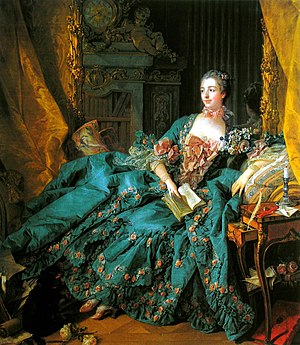Jeanne Antoinette spent most of her childhood at a convent which was custom for young bourgeois girls and the time at the convent was good for her - she received a good education that would come in handy later on. When she left the convent at fifteen her mother was determined to continue her education and did so by hiring different tutors for her daughter. This meant that Jeanne Antoinette became a very talented singer, dancer, painter and engraver. She especially excelled in acting. A good education was expensive but Normant de Tournehem - he was one of the men suspected to be the real father of "Reinette" and this support gave new life to the rumours.
When Jeanne Antoinette turned nineteen years old she was married off to Charles-Guillaume Le Normant d'Étiolles who happened to be the nephew of her guardian. Their greatest wedding-gift was the estate of Étiolles that was placed on the border of one of the royal hunting forests. The marriage resulted in a son who died at just one year old and a girl named Alexandrine-Jeanne who was given the nickname "Fanfan". Jeanne Antoinette was considered to be very beautiful and her husband absolutely adored her. She even managed to start her own salon at Étiolles that would become a meeting-place for philosophers including Voltaire himself.
Jeanne Antoinette's salon meant that her name was soon heard even in the higher levels of society. Even Louis XV came to hear of Madame d'Étiolles as she was known. She was invited to a mask ball at Versailles on the night between February 25-26 and the King was present. Jeanne Antoinette made a deep impression on the King and by March she was known to be the King's mistress and had been given apartments at Versailles. The separation between Jeanne Antoinette and her husband was announced on May 7.
It was impossible to be presented at court without a title. The King bought the marquisate of Pompadour for his mistress thus making her the Marquise de Pompadour with coat-of-arms, lands and château. The King's cousin the Princess de Conti escorted the Marquise de Pompadour on her official presentation at court September 14 and Jeanne Antoinette was now officially a part of the French court.
Despite not having any direct political power, the Marquise de Pompadour was still not to be underestimated. She was known as a supporter of the Maréchal de Belle-Isle and when Marie-Louise
O'Murphy de Boisfaily tried to replace Madame de Pompadour she was quickly sent away. It was a well-known fact at other European courts that Madame de Pompadour could be used to get access to the King. This was also the case when an Austrian diplomat asked Madame de Pompadour to intervene in the strained relationship between France and Austria - this led to the Treaty of Versailles. It was the first time that the King had taken a bourgeois lady as his mistress and the court was not pleased. Many courtiers - especially those of the old generation - thought it was despicable and consequently loathed the marquise.
 After the Seven Years War France was almost bankrupt and internationally humiliated. Despite this Madame de Pompadour continued to support the politics that had resulted in the loss of the French colonies in America to the arch-enemy of England - many in the public blamed the King's mistress.
After the Seven Years War France was almost bankrupt and internationally humiliated. Despite this Madame de Pompadour continued to support the politics that had resulted in the loss of the French colonies in America to the arch-enemy of England - many in the public blamed the King's mistress.Madame de Pompadour was different from the previous mistresses of Louis XV. First of all she had established a good relationship with the Queen Marie Leszczinska - despite the strange nature of their relationship. Besides, Jeanne Antoinette knew that the King was melancholic and understood that she had to do everything in her power to cheer him up; she kept him occupied with card games, hunting parties and the theatre.
Jeanne Antoinette loved architecture and began the planning of a small mansion located on Versailles' grounds - the Petit Trianon. She was the main reason that Sèvres would become a favourite porcelain manufacturer of the court. Literature was another main interest of the maîtresse-en-titre. Her influenced peaked in the 1750's when Louis XV allowed her to fill the vacant positions in different political areas which gave her a great deal of power. She was a patron of several artists whom she would use in her own apartments.
 |
| Memorial portrait |
It should be stated that the King's mistress was not actually sleeping with the King any longer - instead she provided him with a friendship he desperately needed and that he would eventually be dependent of. Madame de Pompadour had suffered to miscarriages in 1746 and 1749 after which the sexual relationship ended. She would procure the King with several girls that he could amuse himself with sexually but he remained devoted to her.
Madame de Pompadour caught tuberculosis when she was forty-two years old. The illness caused her to suffer immense pain during the last weeks of her life. Jeanne Antoinette died in 1764. Louis XV witnessed her coffin's departure from his apartment at the first floor overlooking the Marble Courtyard - tears fell down his cheeks.


she was very important mistress in the King louis xv life
ReplyDelete